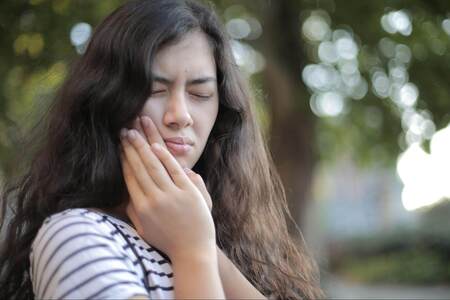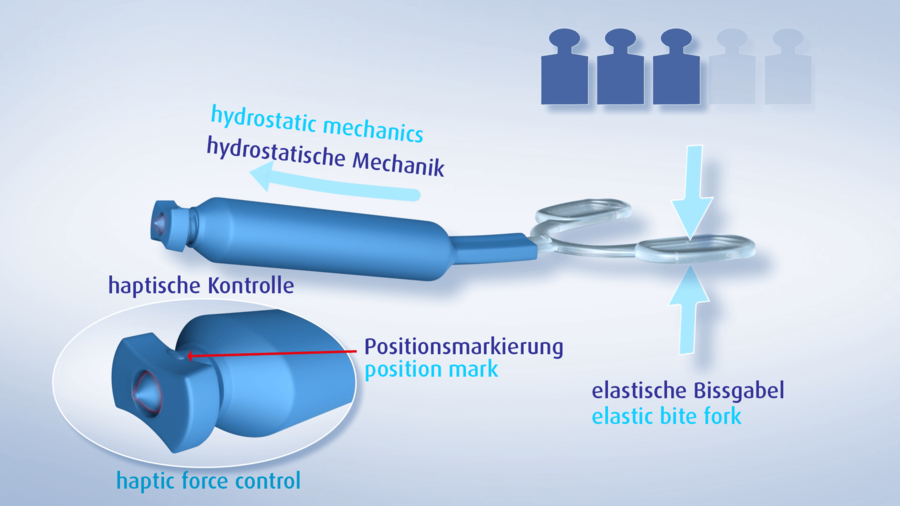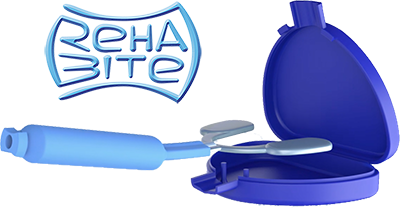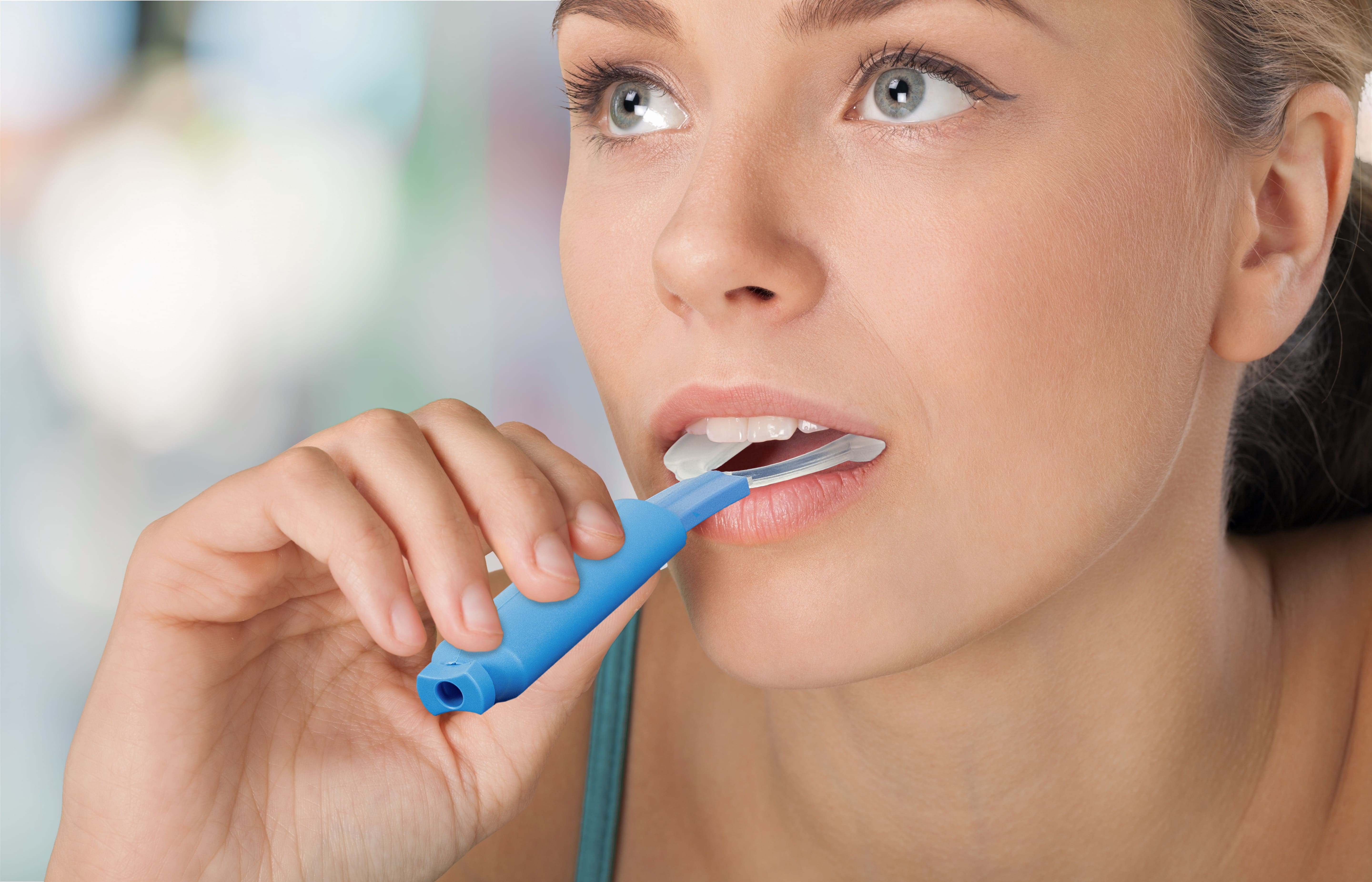The jaw is the strongest muscle in our body – accordingly, it can cause great discomfort. Therefore, it is essential to take good care of it and treat complaints sustainably. If you experience TMJ and a sore jaw, it can affect large parts of your body, causing not only physical discomfort, but also psychological stress. With the RehaBite jaw muscle trainer, you can perform relaxation exercises for jaw pain all by yourself from the comfort of your home. With the bite fork made of two fluid-filled bite pads, you are able to treat symptoms of the TMJ syndrome and exercise your jaw muscles.
Content
- What is the RehaBite?
- Jaw muscles training: how the RehaBite works
- TMJ therapy: How to use the RehaBite
- Diagnosis & Treatment: Is the RehaBite suitable for me?
- Information for dentists, osteopaths & psychotherapists
- TMJ self-help: the Aqualizer
- New bite splint for TMD complaints: the RehaSplint
- FAQ
What is the RehaBite?
The RehaBite is the first innovative physio-therapeutic exercise device for TMJ treatment at home and for the treatment of jaw disorders. It is a glycerin-filled elastic bite fork with integrated force control. The RehaBite enables sensorimotor (coordinative) intraoral training. It is a hydrostatic system that causes the neuromuscular system to balance the right-sided and left-sided masticatory muscles under force-controlled conditions. With this, you rehabilitate muscle pain in the masticatory system and perform jaw exercises for TMJ yourself – easily from home.
How to use the physio-therapeutic training device:
- for exercises against TMJ
- for misaligned jaw exercises
- to relax the jaw in case of TMJ complaints
- as TMJ physiotherapy
- as a coordinative masticatory muscle trainer with bio-feedback
- as a treatment for uneven chewing pressure
- to dissolve pain-induced relieving posture
- as an alternative to medication or expensive occlusal splints
TMJ exercises: how the RehaBite works
The RehaBite is the first physio-therapeutic training device that enables force-controlled intraoral training as if under training conditions. Thanks to the hydrostatic system – similar to balancing on a seesaw – you distribute the force of your jaw evenly and prevent relieving postures.
With the RehaBite, you train the muscular structures of the jaw evenly so that both sides work again in a coordinated and functional manner. The RehaBite has the same effect as an occlusal splint. You can use it to relax your jaw muscles, release jaw tension and relieve unnatural postures.
Studies such as the one conducted by PD Dr. Daniel Hellmann and Prof. Dr. Hans J. Schindler show that muscle activity improves and jaw opening restrictions are relieved after only a short time. In the randomized clinical trial, patients with painful myoarthropathy were treated in comparison with a conventional occlusal splint and the RehaBite. Myoarthropathy of the masticatory system manifests as pain and dysfunction of masticatory muscles and temporomandibular joints due to stress and malocclusion. Both groups showed a significant reduction in pain, with the RehaBite significantly reducing pain.
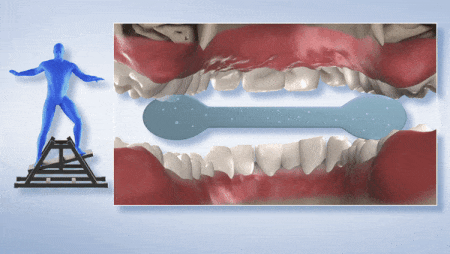
The training device has five adjustable intensity levels for your jaw workout. This is how you apply the device, strengthen your jaw muscles and realign your jaw:
- Bite down on the elastic bite fork until you reach finger feedback.
- Hold this steady tension for about 10 seconds.
- Repeat the process - 3 x 10 repetitions are recommended.
- After that, open the jaw and stretch it with your fingers until you reach the pain threshold.
- Exercise about 2-3 times a day for 5 minutes.
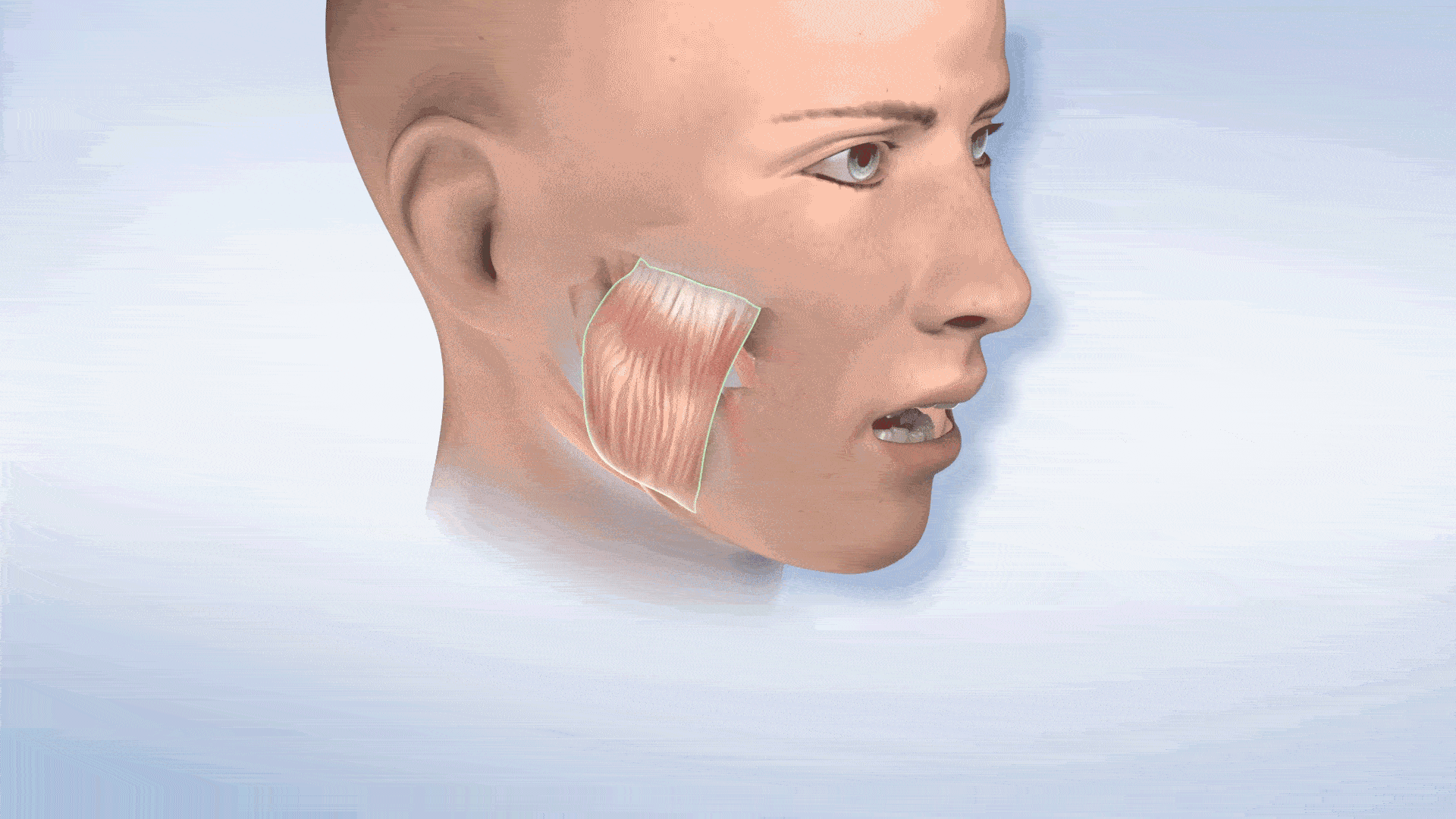
Jaw strengthening exercises have played a significant role in jaw relaxation and TMJ pain relief. A study on the mode of action of occlusal bite blocks by Bernd Kordaß et al. showed that significant improvements in muscle activity occur after just 2 weeks. Accordingly, the muscles relaxed noticeably and pain in the jaw and face decreased.
In the study, a patient was introduced with TMJ symptoms that had worsened over 3 months – such as pain in the face and jaw, teeth grinding, jaw opening disorders and jaw clicking. Bite blocks were used to relieve dysfunctional patterns, posture, and tension.
The goal of the RehaBite therapy is to evenly distribute chewing pressure to resolve painful relieving postures. The RehaBite offers an alternative to the occlusal splint and is ready for immediate use. Therefore, you do not need any further medication.

Note:
Coordinate the intensity of the home exercises with your physiotherapist or dentist and carry out the RehaBite® training procedure together first. This procedure will help you avoid incorrect or overstressing training.
Specific symptoms which can be treated with a RehaBite include:
- Jaw cracking, temporomandibular joint blockages and jaw misalignments
- Pain of the jaw muscles and the jaw joints
- Difficulties in chewing
- Disturbing sensation of individual teeth
- Nocturnal teeth grinding (bruxism)
- Tension headache (migraine)
- Pain/tension in the neck, throat, shoulders and back
- Permanent ringing in the ears (tinnitus)
- Dizziness, balance disorders
- Jaw arthrosis as a late consequence
- Increased sensitivity to light
Your physician diagnoses the clinical picture through a clinical functional analysis. If necessary, the diagnosis is specified by axiography or EMG.
In addition to jaw muscle training and TMJ therapy exercises, the RehaBite is also used by stroke patients, patients with jaw opening restrictions or with pronounced muscular imbalances.
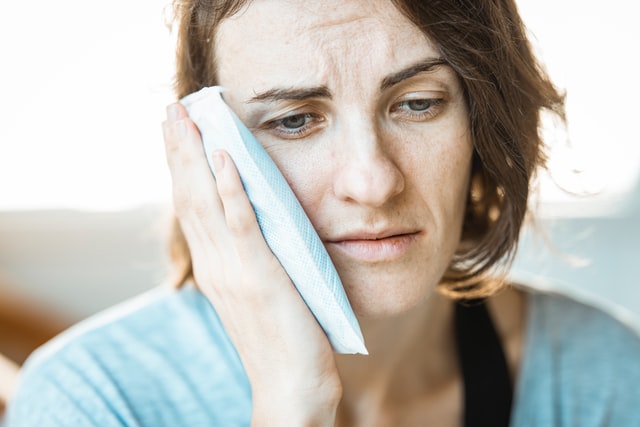
Just four steps to your instant help splint
Select item
Choose from different payment options
Daily shipping
Treatment of TMD
| Quantity | Unit price |
|---|---|
| To 2 |
€87.86*
|
| To 4 |
€83.47*
|
| To 9 |
€81.27*
|
| From 10 |
€79.08*
|
Available, delivery time: 1-3 Tage
For treating dentists, osteopaths & psychotherapists
Not only dentists treat jaw complaints with the RehaBite. Due to the wide range of symptoms, osteopaths and psychotherapists also use the RehaBite. Tense chewing muscles not only affect physical health, but also mental health. On the other hand, other diseases as well as psychological problems can trigger discomfort in the temporomandibular joint. As a practitioner you will receive exclusive offers from us.
Further products
With the Aqualizer you can supplement your relaxation exercises for the jaw. The water-filled relaxation splint relaxes your chewing muscles – the Aqualizer offers immediate TMJ relief and help especially for these symptoms:
- Teeth grinding
- Tension headaches
- Back pain
In contrast to customized, hard grinding splints, the Aqualizer is not custom-made, but is produced in different models with different water fillings for children and adults:
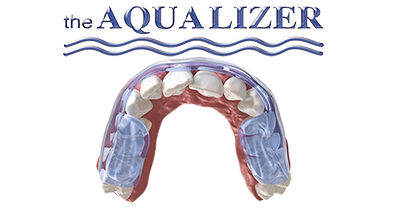

Our new bite splint offers immediate help for TMD symptoms. The temporary bite splint prevents neuromuscular adaptations and thus improves your quality of life. It relieves adapted postures of the lower jaw and reduces pain in case of muscular impairment due to overloading, tension due to postures or changes in the bite position. You can use the RehaSplint for various symptoms, complaints and clinical pictures, for example:
- Occlusal disorders
- Bruxism (teeth grinding or clenching)
- Muscular imbalances
- Tension due to relieving postures
- TMD complaints
The grinding splint is available in three different versions:
The RehaSplint can be used as a sustainable alternative to the Aqualizer.
Do you have questions about the RehaBite or our other products?
You suffer from jaw complaints and would like to find relief with the RehaBite? It is our concern to relieve you of your suffering – we will be happy to advise you.
Or are you a therapist and use the RehaBite to treat physical or psychological symptoms and causes in your patients? Then you can get exclusive offers from us.
Contact us by phone at +49-221-9742834 or by mail to info@dentrade.de. Alternatively, you can use our contact form. We are looking forward to your message!
Why order from Dentrade?
Treatment of TMD
Worldwide shipping
Relief of head, jaw and neck pain
Cooperation with leading TMD experts
In dental practice, musculoskeletal pain of the temporomandibular joint (TMJ) is usually treated with occlusal splints and/or the use of medication.
An occlusal splint is an important tool to relax the masticatory musculature and interdisciplinary musculoskeletal system, as TMJ is the cause of 80 % of all head, neck and back pain. Recent scientific findings show that coordinative training contributes an essential component to the rehabilitation of the craniomandibular system.
With the RehaBite, daily temporomandibular joint exercises train your jaw muscles and, with regular training, enable successful muscle pain therapy. The RehaBite can be used as an alternative or supplement to the bite splint (e.g. RehaSplint or Aqualizer) .
The RehaSplint is a grinding splint, the RehaBite is a physiotherapeutic training device.
The two devices differ in their application:
RehaBite:
- Active therapy option for CMD
- Elastic bite fork filled with glycerine
- Use 2-3 times daily for 5 minutes
- 5 adjustable intensity levels
- Hydrostatic system
RehaSplint:
- Passive therapy option for CMD
- Temporary grinding splint
- Can be worn both at night and during the day
- 3 different degrees of hardness
- Elastomer
The RehaBite is widely used in the rehabilitation of stroke patients to restore the balance of the jaw muscles. Patients with very limited mouth opening have also been able to achieve excellent results because they determine the intensity of the training themselves.
Some patients find a splint uncomfortable and unhelpful at night. For these, the RehaBite is an optimal alternative. The reason: the RehaBite does not force the jaw into a special position. Since it is not possible to use a customized splint during orthodontic treatment, the RehaBite or even a RehaSplint is an ideal aid during therapy.
Regular training of only 15 minutes a day significantly reduces the discomfort and pain associated with CMD.
In the first step, you should use a RehaSplint or Aqualizer for acute pain reduction in muscular dysfunction to relieve the jaw's protective posture. After that, you start with the RehaBite training at intensity level 1. Increase the strength level weekly.
As soon as pain occurs, you should lower the training to intensity level 1. The coordinative masticatory muscle training gives the patient biofeedback to slowly dissolve the pain-induced protective posture.
The bite fork has five intensity levels. If you do not suffer from limited mouth opening or acute pain, you can start with level 3. One training set includes 10 repetitions, which should be performed 3 times a day. While doing so, bite down on the two fluid-filled bite pads until you feel haptic control. Initial improvements occur after only two weeks. Please discuss the treatment with your physiotherapist or dentist.
The dentist has the option to refer you to a physiotherapist in case of a reflex disorder of the cervical spine in connection with a myoarthropathy. Depending on the scope of benefits of the health insurance, the RehaSplint, Aqualizer or RehaBite can be included in the therapy. The extent to which the individual health insurance companies cover the costs of private services must be checked individually with the health insurance company and the therapist, as there are no general regulations. This also applies to treatment by an alternative practitioner or osteopath.

